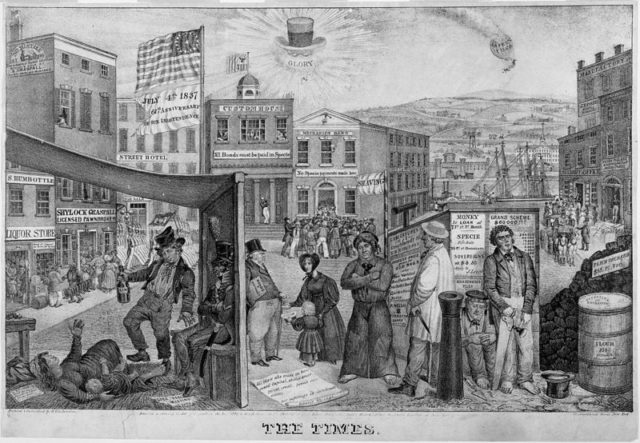On a winter’s night in early 1837, sudden violence erupted on the streets of New York City; it was an event that became known as the ‘Flour Riot.’ Sparked by a fear that food was being stockpiled by rich merchants in Lower Manhattan, as well as the fear that people of lower status might encounter starvation, the city warehouses were attacked.
In fact, the food shortage rumors which incensed the crowd were very much exaggerated. And the vandalism and violence which ensued were not excessively damaging, especially when taken in comparison to later disturbances such as the colossal Draft Riots or the Astor Place Riot.


Nonetheless, the Flour Riot did stand out in memory. The sudden and violent event provided a strong indication of the widening divide in the city between a class of prosperous merchants and a quickly increasing number of lower class, newly arrived immigrants.
The riot also propelled a shockwave through New York City because an innovative method of communication had helped to inflame the tensions; the penny press – mass produced, inexpensive newspapers. Inexpensive newspapers, widely accessible to the poor and lower class, had spread inciteful rumors which provoked a mob to attack a warehouse storing flour.
The US was encountering several economic problems in the mid-1830s, and one of them was a rise in the price of wheat, which brought financial hardships directly into the homes of average folks. By February 1837, in the preceding three years, the price of flour had tripled to around twelve dollars a bushel.
As the increasing price of bread became a problem, the poorer classes of New York City were feeling oppressed and grew ever angrier. Tabloids began turning up in lower Manhattan pleading for people to attend a meeting on Monday, February 13, at 4 pm at City Hall Park.
Rumors swirled around all during the weekend. James Gordon Bennett, the owner of The New York Herald, a markedly aggressive newspaper, had already stated ‘an atrocious and appalling treachery by rich speculators’ was trying to take advantage of famished citizens.

It was alleged that a few merchants had huge inventories of flour in their warehouses and they were stockpiling it to push up the price.
The town-hall type meeting on Monday amassed a crowd of about 5,000 New Yorkers, a huge turnout when you consider the harsh winter weather. Several speakers spoke to the crowd about current economic conditions, and the meeting had the atmosphere of a typical election rally, as most of the speakers were former candidates for city offices.
However, the last speaker turned the meeting into something else altogether. The man, who has never been accurately identified, took the podium and began attacking the merchant firm of Hart and Company. The speaker declared that Hart’s company held 53,000 barrels of flour in its warehouse, which was only a short trek from where the rally was being held.
Members of the audience began to yell – ‘To Hart’s store!’ And while the other speakers, the local political leaders, pleaded for everyone to remain calm, an infuriated mob flooded into the streets and headed to Hart’s warehouse on Washington Street.
Cornelius Lawrence, the mayor of New York, tried to calm the crowd when they reached the flour warehouse. He was bombarded with rocks and swiftly retreated.
The mob charged the building, burst into the warehouse, and began tossing barrels of flour out onto the street.
City Watchmen, forerunners of the police force, tried to disperse the crowd but failed miserably. Eventually, a local militia garrison arrived, and the crowd dispersed.
Two other flour warehouses were hit by the crowd later the same night, but by then the anger of the mob had diminished and there were no significant deeds of destruction.
The brief, but furious assembly of the mob produced no severe casualties. And while a grand jury investigated the events of that night, the ringleaders and participants merged back into the city surroundings and evaded punishment.
One change stimulated by the Flour Riot was that more city watchmen were hired to strengthen the security in the city. And it was an indication that the rapidly growing city would eventually require a professional police force.

And the commotion that shook New York City on 13 February 1837 was actually the predecessor of a major nationwide event. A month later, triggered by southern cotton dealers defaulting on loans, a Wall Street firm collapsed, About Education reported.
The Panic of 1837 was about to transpire, and a major economic depression rattled the country. And the angry people seizing flour on a wintery night in Lower Manhattan seemed to have foretold of the national calamity.
